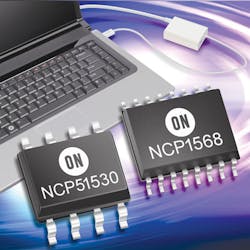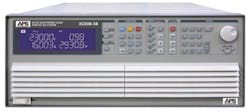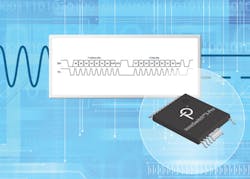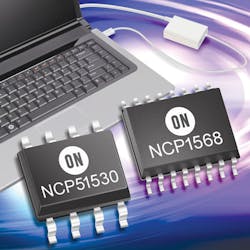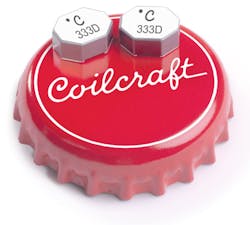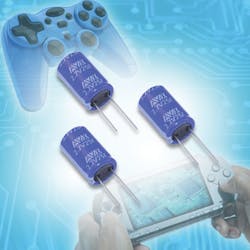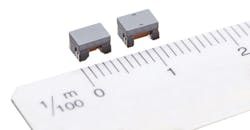Software, components, and instruments power APEC exhibits
San Antonio, TX. APEC 2018, held March 4-8, provided a venue for many companies to exhibit their products and technologies, from power devices to instruments and systems, as described in our March report on the topic.1 Those companies included B&K Precision, Chroma, HBM, Hioki, Kikusui Electronics, Preen AC Power Corp., Rohde & Schwarz, Tektronix, Venable Instruments, Versatile Power, Vitrek, and Yokogawa. In addition, Magna-Power highlighted its MAGNADC programmable DC power supplies and MAGNALOAD DC electronic loads; Ira J. Pitel, the company founder, elaborates on the technology behind the latter in an article in our April issue.2
Also at APEC, companies highlighted many additional products as well, having chosen the event to present their new products for the first time. For example, Adaptive Power Systems featured a new range of programmable AC loads. The new 3C038-38 programmable AC load (Figure 1) supports 3,750 W or VA loading and up to 350-VAC input, according to Herman vanEijkelenburg, director of marketing. For higher power requirements, units can be paralleled. A three-phase delta or wye control mode allows a master/auxiliary three-phase load configuration using three loads. Also available are lower power versions at 1,875 W or VA and 2,800 W or VA.
Courtesy of Adaptive Power Systems
Keysight Technologies featured a variety of programmable power supplies and other instruments, but a key focus of the company’s exhibit was the Keysight PD1000A power device measurement system for advanced modeling and the W8598BP/BT power electronics model generator software. The company described the products as new state-of-the-art tools for modeling and simulation of power-electronics devices, adding that they address the growing requirements of electronics designers in the hybrid-electric and electric-vehicle (HEV/EV) industry, as well as the solar industry, to make their modules smaller, cooler, and more efficient by using new wide-bandgap semiconductors in their designs.
With PD1000A, you can easily create simulation models for any wide-bandgap semiconductor device with real measurements, right on your bench, the company said. Control software provides access to advanced measurement features to gather modeling parameters from three systems:
- A curve-tracer system measures I-V and C-V characteristics.
- An S-parameter system measures on- and off-state
- S-parameters.
A double-pulse tester to be released soon will measure extended I-V characteristics.
The W8598BP/BT power electronics model generator software uses the gathered measurements to create advanced power device models for Keysight ADS, EMPro, and Momentum simulation software.
Wide-bandgap semiconductors
Indeed, wide-bandgap semiconductors were a key focus of the show. Highlighting silicon-carbide devices was Littelfuse, which participates in the SiC market through its investment in Monolith Semiconductor Inc., a 2015 initiative to develop power semiconductors for industrial and automotive markets. At APEC, Littelfuse and Monolith announced the addition of two 1,200-V SiC n-channel, enhancement-mode MOSFETs to their expanding first-generation portfolio of power semiconductor devices. The LSIC1MO120E0120 and LSIC1MO120E0160 SiC MOSFETs offer ultralow on-resistance (RDS(ON)) levels of just 120 mΩ and 160 mΩ, respectively. At APEC, Monolith CEO Sujit Banerjee said one problem is that customers have trouble evaluating SiC devices because of the limitations of their existing measurement systems. In an upcoming issue of EE-Evaluation Engineering, representatives of Littelfuse and Monolith will address challenges related to the dynamic characterization of power-semiconductor devices.
Another wide-bandgap semiconductor front-and-center at APEC was gallium nitride. Whereas SiC serves the higher voltage applications, GaN finds use in the space between existing silicon solutions and SiC—from laptop and cellphone adapters to 48-V automotive mild-hybrid systems.
Jim Witham, GaN Systems’ CEO, said the company covers the gamut of GaN applications. To help customers get up to speed, the company offers its own evaluation boards, and others are available from third parties. GaN Systems at APEC unveiled what it calls the industry’s highest current and power-efficient 100-V GaN power transistor, the 100-V, 120-A, 5-mΩ GaN E-HEMT device (GS-010-120-1-T). It offers 1.3x the current rating of GaN Systems’ own 90-A part and 2.4x to 4.6x the current rating of other high-current GaN devices in the industry, the company said. The GS-010-120-1-T is an enhancement-mode GaN-on-silicon power transistor that leverages GaN Systems’ die design and packaging advantages.
The transistor is suitable for the growing 48-V applications in the automotive, industrial, and renewable-energy industries that require power systems with high power levels in smaller size form factors, the company said, adding that bringing products like the GS-010-120-1-T to market results in longer range electrical vehicles, lower-operating-cost renewable-energy equipment, and smaller, highly integrated industrial power equipment.
Also touting GaN at APEC was startup Navitas Semiconductor, which announced what it calls the world’s smallest, fastest-charging mobile adapter enabled by GaNFast power ICs. The 27-W design delivers 5x greater power than standard smartphone chargers and has 2x higher power density, the company said, adding that with worldwide input voltage capability and a new Type-C connector with USB-PD 3.0 and Qualcomm Quick Charge 4.0 features, this lightweight reference design delivers a portable “go anywhere, charge anything” solution. Backing up that contention at the Navitas booth was Matthew Judkins, CEO of MADE IN MIND mu Ltd., who demonstrated a prototype that could charge a cellphone, tablet, or laptop, all in the size of a compact cellphone, including the mechanical prongs that could be unfolded to accommodate European, British, or U.S. electrical outlets.
In other news related to wide-bandgap devices, Analog Devices Inc. in collaboration with Microsemi Corp. introduced a high-power evaluation board for half-bridge SiC power modules delivering up to 1,200 V and 50 A at a 200-kHz switching frequency. The isolated board improves design reliability while also reducing the need to create additional prototypes—saving time, lowering costs, and decreasing time to market for power-conversion and energy-storage customers, the companies said.
The new board can be used as the building block for more complex topologies, such as full-bridge or multilevel converters, for complete bench debugging of customer solutions. It can also function as a final evaluation platform or in a converter-like configuration for full test and evaluation of Analog Devices’ ADuM4135 isolated gate driver with iCoupler digital isolation technology and LT3999 DC/DC driver in a high-power system.
The high-power evaluation board enables Microsemi’s SiC power modules to provide benefits such as a common test bench, higher power density for reduced size and cost, and isolated and conductive substrates and minimum parasitic capacitance for improved efficiency, performance, and thermal management. These attributes make the board suitable for applications including electric-vehicle (EV) charging, hybrid EV (HEV)/EV onboard charging, DC/DC converters, switched-mode power supplies, high-power motor control and aviation actuation systems, plasma/semiconductor capital equipment, lasers and welding, and MRIs and X-rays.
LED power
Other semiconductor companies exhibiting at APEC included pSemi Corp., formerly Peregrine Semiconductor and now a Murata company. The company has been known in the RF arena, but through an acquisition, is now in the power business. pSemi introduced at APEC the PE23300 fully integrated LED boost power supply in package (PSiP) based on a charge-pump, switched-capacitor architecture that offloads most of the power-conversion work from the inductor to capacitors in the charge pump. Powering up to eight LED strings at a total power level of up to 10 W, the PE23300 can power LED backlight arrays in ultrahigh-definition (UHD) and high-definition (HD) LCD panels for two-cell and three-cell narrow-voltage DC notebooks as well as industrial and automotive displays.
“The PE23300 truly demonstrates pSemi’s power-semiconductor capabilities,” said Stephen Allen, director of strategic marketing at pSemi. “The PSiP delivers a unique, two-stage architecture that brings ground-breaking conversion efficiency and small solution size, and is packaged with Murata’s advanced, 3D-packaging technology and passive components. All components required for operation are integrated into a 7.7 x 11.7-mm laminate-based LGA package, which is just 1.6 mm in height.” He attributed the compact size to a “die-in-substrate” 3D-packaging technology and to the company’s two-stage architecture that permits the use of a tiny chip inductor.
In addition, Murata announced it has expanded its product range of embedded-core-technology DC/DC converters with the NXF1 fully regulated, high-isolation converter with 3.3-V or 5-V outputs. Inputs available are nominal 3.3 V and 5 V in an industry-standard surface-mount package with a low profile. Line regulation is typically better than 0.03%, and load regulation is typically better than 0.5%. All parts have continuous short-circuit protection with auto restart or latch-off, depending on model and temperature. Input range is ±5 % around the nominals of 3.3 V and 5 V. Packaging is the industry-standard footprint for SMT 1-W converters in the Murata proprietary iLGA inspectable format with gold-plated terminations.
Power-supply ICs
Power Integrations at APEC announced the release of its InnoSwitch3-Pro family of configurable off-line CV/CC and CP flyback switcher ICs (Figure 2). Capable of delivering up to 65 W and achieving up to 94% efficiency across line and load conditions, the new devices permit precise, dynamically adjustable control of voltage (10-mV step) and current (50-mA step) via a simple two-wire I2C interface. Devices may be paired with a microcontroller or take inputs from the system CPU to control and monitor the off-line power supply. Applications include virtually any rapid-charging protocol, including USB Power Delivery (PD) 3.0 + PPS, Quick Charge 4/4+, AFC, VOOC, SCP, FCP, and other industrial and consumer battery chargers, dimmable LED ballast drivers, and field-configurable industrial power supplies.
Courtesy of Power Integrations
“The AC/DC power-conversion market is undergoing rapid transition, with system designers needing a programmable solution that can adapt to various fast-charging protocols including the recently completed USB PD 3.0 + PPS specification,” said Shyam Dujari, director of product marketing for Power Integrations. “The ability to precisely control the output voltage and current of a power supply over a wide range is also useful for designers of specialized applications with smaller production runs, as they can easily configure a single-board design for multiple product SKUs using software either at manufacture or during installation.”
Helix Semiconductors touted the start of mass production of its MxC200, a configurable high-efficiency 15-W DC/DC power IC. Previously known as the HS200, the MxC200 takes an input ranging from 12 to 48 V and converts it to selectable lower voltages. President and CEO Harold Blomquist said applications for the MxC200 include a variety of products such as wireless access points, security cameras, IoT gateways, and VoIP phones—as well as 24-V to 48-V intermediate bus converter applications and 48-V input telecom and Power-over-Ethernet applications. The MxC200 also targets products with 24-V inputs, such as HVAC systems and industrial controllers. In fact, the device is flexible and can perform voltage conversions on input voltage ranging from 12 to 48 V with output voltage as low as 3.0 V.
According to Blomquist, “With the MxC200 and other MuxCapacitor-based products, Helix Semiconductors is answering the demand for more energy-efficient power ICs in the burgeoning AC/DC and DC/DC markets. The MxC200 features a unique three-stage process, each of which divides its input in half. Power can be pulled from any of its three outputs simultaneously up to 15 W. The company’s MuxCapacitor technology enables the MxC200 to achieve unprecedented high efficiency and to stay nearly flat, from full load down to 5% load.”
In addition, ON Semiconductor introduced a new solution for high-density power adapters for notebooks, tablets, and other portable devices that require compatibility with the USB Power Delivery (USB PD) or Qualcomm Quick Charge specifications. The solution, which includes multiple patents pending, comprises the NCP1568 active-clamp-flyback (ACF) controller and a corresponding high-speed, half-bridge driver—the NCP51530 (Figure 3). The solution enables a 65-W USB-PD-compliant adapter with a 30-W/in.3 power density while operating at 94.5% peak efficiency.
Courtesy of ON Semiconductor
The company described the NCP1568 as a highly integrated AC/DC pulse-width-modulation (PWM) controller that implements an ACF topology, including zero-voltage switching (ZVS) for high-frequency applications (up to 1 MHz) that demand high levels of power density and efficiency. Furthermore, the NCP1568 controller can implement ACF topology with super-junction (SJ) FETs or with high-performance GaN FETs.
In addition, Microchip highlighted its solutions for power-supply and motor control. The company said its intelligent power-supply implementations extend from basic intelligent control/integration, with microcontrollers performing supervision and sequencing, to advanced digital control engines that integrate ADCs, digital-control algorithms, and PWM generators to close the control loop with firmware. Applications include wireless charging, AC/DC and DC/DC power supplies, DC/AC inverters, battery management, and digital lighting control. For solar-power applications, the company offers reference designs that include support for power-path management and maximum power-point tracking (MPPT).
Passive components at APEC
Passive-component makers were also on hand at APEC with new products. For example, TT Electronics launched the HA19 Series common-mode chokes for use in electronic power-steering (EPS) noise-suppression applications. With high-performance and AECQ-200 certification, the HA19 Series devices are “automotive ready” for the new generation of motor vehicles, the company said. Every EPS system requires proper EMI control with a common-mode choke (CMC) and/or a differential-mode choke (DMC) serving this function, the company added, explaining that with the growing shift to EVs and PHEVs, and the accelerated incorporation of electronic components in automobiles, noise suppression has become increasingly important to ensure EMI compliance.
The HA19 Series includes three parts with standard inductance values ranging from 11 µH to 75 µH, which have been demonstrated to be suitable for reducing line-conducted interference in the circuitry. The devices offer high reliability and current handling from 26.5 A to 44 A (plus higher overcurrent withstanding) in a rugged construction. Their -40 to 125°C operating temperature range and AEC-Q200 certification make them suitable for high-stress automotive environments. The HA19 chokes are lead-free and comply with EU Directive 2011/65/EU (RoHS2) requirements.
Coilcraft at APEC launched its new LPD8035V Series miniature, high-voltage 1:1 coupled inductors (Figure 4). The LPD8035V provides 1,500-VRMS, one-minute isolation (hipot) between windings from a package that measures just 7.92 x 6.4 x 3.5 mm, providing users with size and cost reductions over conventional bobbin-wound alternatives, the company said. It is suitable for flyback, SEPIC, and isolated buck-converter designs. The LPD8035V Series is currently offered in six inductance values ranging from 4.7 to 150 µH. It provides peak current ratings up to 2.7 A, which represents a 40% increase over previous-generation products. It also has a tight coupling coefficient (≥ 0.97). LPD8035V coupled inductors are qualified to AEC-Q200 Grade 3 standards (-40° to +85°C ambient), making them suitable for automotive and other high-temperature applications.
Courtesy of Coilcraft
AVX Corp. chose APEC to present its latest lines of capacitors, including supercapacitors, power-film capacitors, and a new case style for its multianode, ultralow-ESR tantalum capacitors. The company also touted MLCCs for space and satellite communications applications.
The company’s new SCC Series cylindrical, electrochemical, double-layer supercapacitors (Figure 5), rated for 2.7 V, deliver capacitance values from 1 F to 3,000 F, low ESR (from 0.16 mΩ to 200 mΩ at 1,000 kHz), low leakage (6 µA to 5,800 µA), high energy density (1.2 to 5.6 Wh/kg), and long lifetime performance (50,000+ cycles). Available in a range of case sizes with diameters spanning 6.3 mm to 60 mm, case lengths spanning 12 mm to 165 mm, and either radial, solder pin, or cylindrical leads, the SCC Series introduces the industry’s smallest 1-F/2.7-V supercapacitor to market, the company said. SCC Series supercapacitors are rated for use in operating temperatures spanning -40°C to +65°C (or, with voltage derated to 2.3 V per cell, -40°C to +85°C).
Courtesy of AVX Corp.
And finally, TDK exhibited a variety of components, such as its expanded line of ALT4532 Series pulse transformers with new types for Gigabit Ethernet and Power over Ethernet (PoE) applications (Figure 6). The new ALT4532P type is designed for emerging 2.5GBASE-T (2.5-Gb/s) and 5GBASE-T (5-Gb/s) LAN applications as well as 1000BASE-T (1-Gb/s) applications with 600-mA PoE. The new ALT4532H type is compatible with the 10GBASE-T standard (10 Gb/s). The components feature a compact SMD package with dimensions of 4.5 mm x 3.2 mm x 2.9 mm.
Courtesy of TDK
Unlike conventional products with toroidal shaped cores, the new TDK transformers feature a special core design optimized for fully automated production and winding processes, resulting in stable quality, the company said, adding that the discrete ALT4532 types offer designers greater flexibility for circuit-board layouts than conventional LAN modules that combine a pulse transformer and common-mode filters in a single package, for example, enabling mounting on both sides of the PCB. Main applications include LAN interfaces for network devices, communication equipment, digital appliances, and IoT devices.
Next year’s APEC will be held March 17-21, 2019, in Anaheim, CA.
References
- Nelson, Rick, “Controlling power for today’s applications,” EE-Evaluation Engineering, March 2018, p. 6.
- Pitel, Ira J., “Electronic loads—a new generation,” EE-Evaluation Engineering, April 2018, p. 18.
About the Author

Rick Nelson
Contributing Editor
Rick is currently Contributing Technical Editor. He was Executive Editor for EE in 2011-2018. Previously he served on several publications, including EDN and Vision Systems Design, and has received awards for signed editorials from the American Society of Business Publication Editors. He began as a design engineer at General Electric and Litton Industries and earned a BSEE degree from Penn State.
